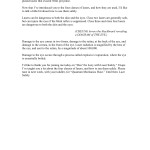Please View Presentation at: http://prezi.com/ou3ojjwurovl/holograms/
Data: To be viewed in person through a self-constructed hologram.
In physics terminology the hologram is defined as such: “a hologram is a record of the interaction of two mutually coherent light beams, in the form of a microscopic pattern of interference fringes.” To the casual observer this would appear to be an overly complex definition of what appears to us as three-dimensional photograph, however, there fortunately is a middle ground to be found. In the most basic terms, a hologram is an imprinted two-dimensional image that has been exposed to monochromatic light and when properly illuminated in a collimated beam of monochromatic light produces a three-dimensional image. Though holography is often associated with its predecessor, the photograph, their only real similarity is the use of photographic film, for while photography can be described in terms of Euclidean geometry, the hologram relies on the principles of diffraction and interference, which are properties of waves and must be defined through them.
The concept of interference is perhaps best illustrated by the disruption of radio waves in areas with extremely tall buildings. While passing through such an area the receiver in a standard radio receives not one, but two distinct signals: one from the original transmitter and they other from the reflection of that transmission from the buildings. A certainly points the waves are in phase with each other, producing an extremely amplified signal. At other points the waves are out of phase, troughs occurring in one, while the other is at a crest, producing silence as the waves cancel one another out.
The first true hologram was produced in 1948 by Denis Gabor using primarily the concept of interference. Using a transparent lens with a series of opaque lines, he focused a beam of monochromatic light parallel to the lens. The interference that occurred between the beam and the light scattered by the lines was imprinted on a film. Unlike stereoscopic photography, which deceives the human eye by capturing only two portions of the wavefront (locus of all points in a light beam that are in the same phase), producing an illusion of depth that can be discovered by simply changing ones viewing position, Gabor’s film now contained all the information about the wavefront of the object. He now needed only to develop the film just as one would a negative and pass the same collimated beam through it again producing two waves of the same magnitude but opposite signs. One was the reconstructed image of the object from the original scattered wave and the other the conjugate image that appeared on the opposite side of the hologram. However the quality of the image was poor, as the conjugate image and scattered light from the direct beam made viewing the reconstruction difficult. It should also be noted that the image was two-dimensional rather than three-dimensional.
Diffraction is simply the characteristic of light to spread out in a defined matter when passed through a narrow grating. The cosine grating is the most basic from of such narrowing; when a laser beam is passed through it, three beams emerge. Diffraction became useful in the creation of holograms once monochromatic laser light was developed, allowing for the creation of the modern hologram.
The modern hologram is produced in largely the same way as Gabor’s original, however, with some important differences. First the object was three-dimensional, and was placed in a glass cylinder with holographic film taped around the inside. The object is then exposed to concentrated laser light diffracted first through a microscopic objective lens. The object is directly impacted by the central portions of the laser light and the film is impacted by the outer portions of the laser diffraction. The object is then removed and the developed film placed in its original position. When the film is re-exposed to only the portions of laser that directly struck the film a three-dimensional image appears. As laser light is far less chaotic than previous light sources, the image also appears far clearer. Advancements in hologram technology have continued beyond this, allowing for greater variation in color and sharper images, however, the basic procedures have largely remained the same since the advent of proper lighting instruments.
When holograms first appeared in popular imagery during the 1970s the technology instantly seemed to be the stuff “sci-fi” dreams were made of. Popularized through cameos in films like Star Wars and TV shows like Star Trek, holograms fit in perfectly with a techno-romantic vision of the future.
While these fictionalized depictions of the technology remain a mainstay of modern technological lore, the usage of holograms has become quite practical in a contemporary context. Holograms are an important part of daily life. Perhaps the most utilitarian use of the hologram is its government-sanctioned usage. Holographic technology has become an important enforcer of international and domestic tax and tariff laws. Products like alcohol and cigarettes, which have a wide presence on the black market, are subject to duties that must be paid before they are placed on the shelves of legitimate retailers. Holograms are used to ensure that those fees are paid. Individualized holograms (see Prezi à “Government/Security”) are affixed to products of good legal standing. These holograms are difficult to fake and ensure the collection of important governmental revenue. Likewise, similar holograms are attached to driver’s licenses and credit cards to prevent fraud and to ensure legal compliance. American credit firms Visa and MasterCard began their use of holograms with the now famous “Dove Hologram” in 1984. Governments too began placing holograms on identification cards and paper currency in the early 1990s. In this same manner holographic images can also be seen on concert tickets, phone cards, and on consumer products to confer legitimacy.
While security issues are implicit in much of the hologram’s usage the beauty of this technology and the images it can produce are not ignored by artists, advertisers, musicians, and designers. Companies that solicit the use of holograms on their products continually see a spike in sales. The colorful complexity of these fabricated images are eye-catching and visually enticing to consumers. Though holograms are easy enough to create, their presence on products increases the consumer’s perception of value allowing for an increase in both price and prestige. Such is the case in the fashion world. Designer Alexander McQueen’s Fall 2006 line featured a stunning life-size replica of supermodel Kate Moss in a hologram. (See Prezi à Fashion). These capabilities of holographic technology are not new, but the dazzling effect of this artistic usage helped McQueen earn his reputation as a “cutting edge” and “avant garde” designer.
It is not far off to envision a world covered in holographic imagery. American sports retailer Nike Inc. has initiated a large ad campaign of holograms in many of its retail stores. Moreover, Pierre Huyghe’s usage of superimposed holographic imagery in his video-art piece “One Million Kingdoms” helped earn the artist, and his fictionalized character “Ann Lee”, international notoriety in museums across the globe. (See Prezi à Art). Bavarian Motor Works (BMW) employed kinetic hologram technology to help perfect the aerodynamics of the 5-series exterior body. This process has been converted to a museum installation for a permanent exhibit at the BMW Museum in Munich, Germany. Similarly, in 2006 Zebra Imaging out of Houston, Texas revealed its composite for holographic architectural modeling. The company creates holographic models of architectural designs that save space and cut down on the environmental materials required to create layered mock-ups. In almost all segments of the design field, creative professionals are utilizing holograms for their visual appeal and impressive ability to communicate large amounts of information.
Beyond their aesthetic value, holograms are also helping to save lives. The digitization of X-ray technology has allowed doctors and other medical personnel to create three-dimensional holographic images of X-Rays, CAT Scans, and other medical imaging. This type of imaging allows physicians to view life-size depictions of the human body, eliminating the need for many surgeries and improving the accuracy of diagnosis. It is safe to say that holograms have come a long way since Princess Leia famously claimed, through a hologram no less, that Obi Wan Kenobi was her and her world’s only hope.
 Using a handheld Geiger counter, I tested 15 items/appliances for radiation. The results were somewhat unvaried, ranging from 0.01 to 0.03 mR(millirem)/hr .
Using a handheld Geiger counter, I tested 15 items/appliances for radiation. The results were somewhat unvaried, ranging from 0.01 to 0.03 mR(millirem)/hr .




